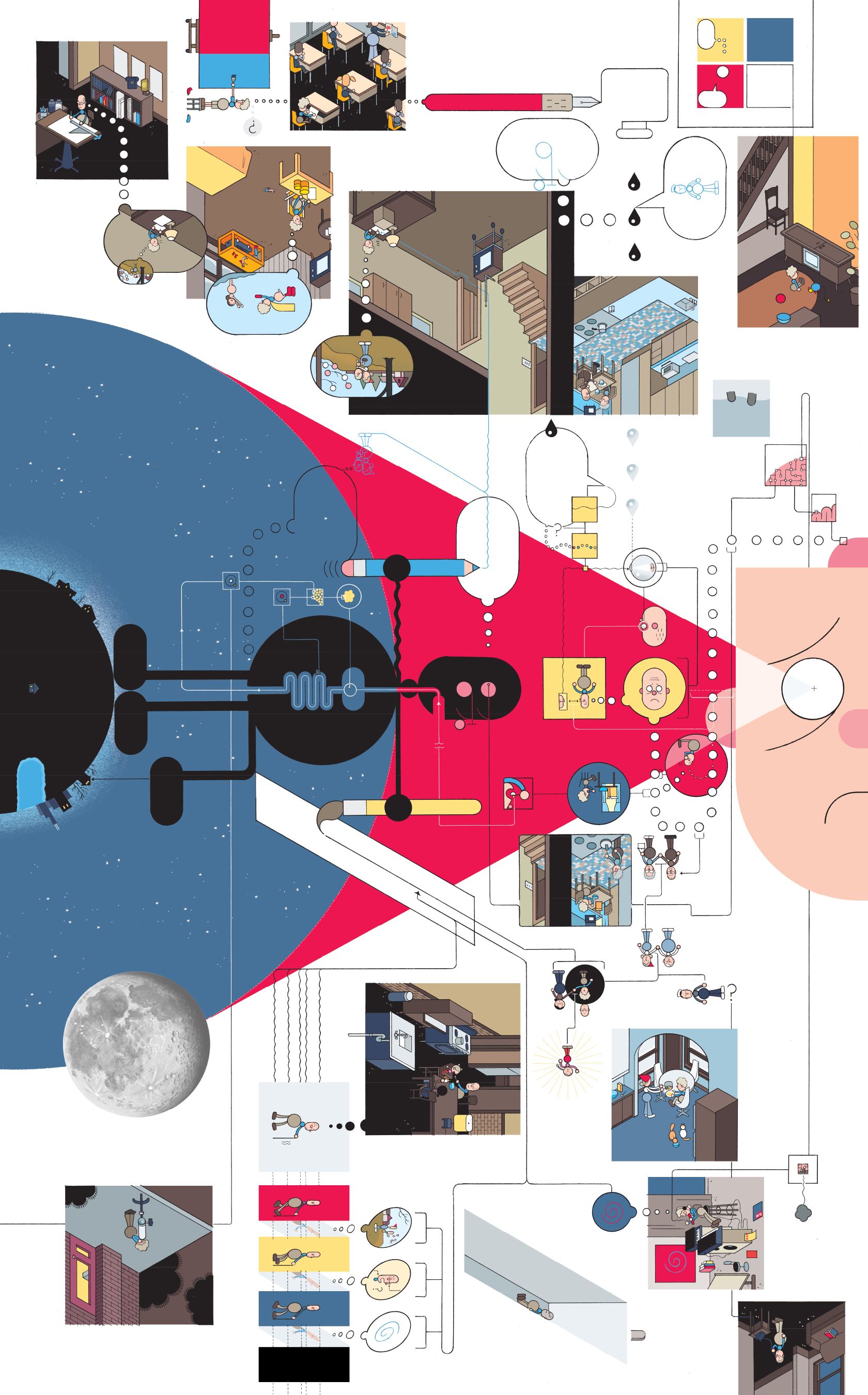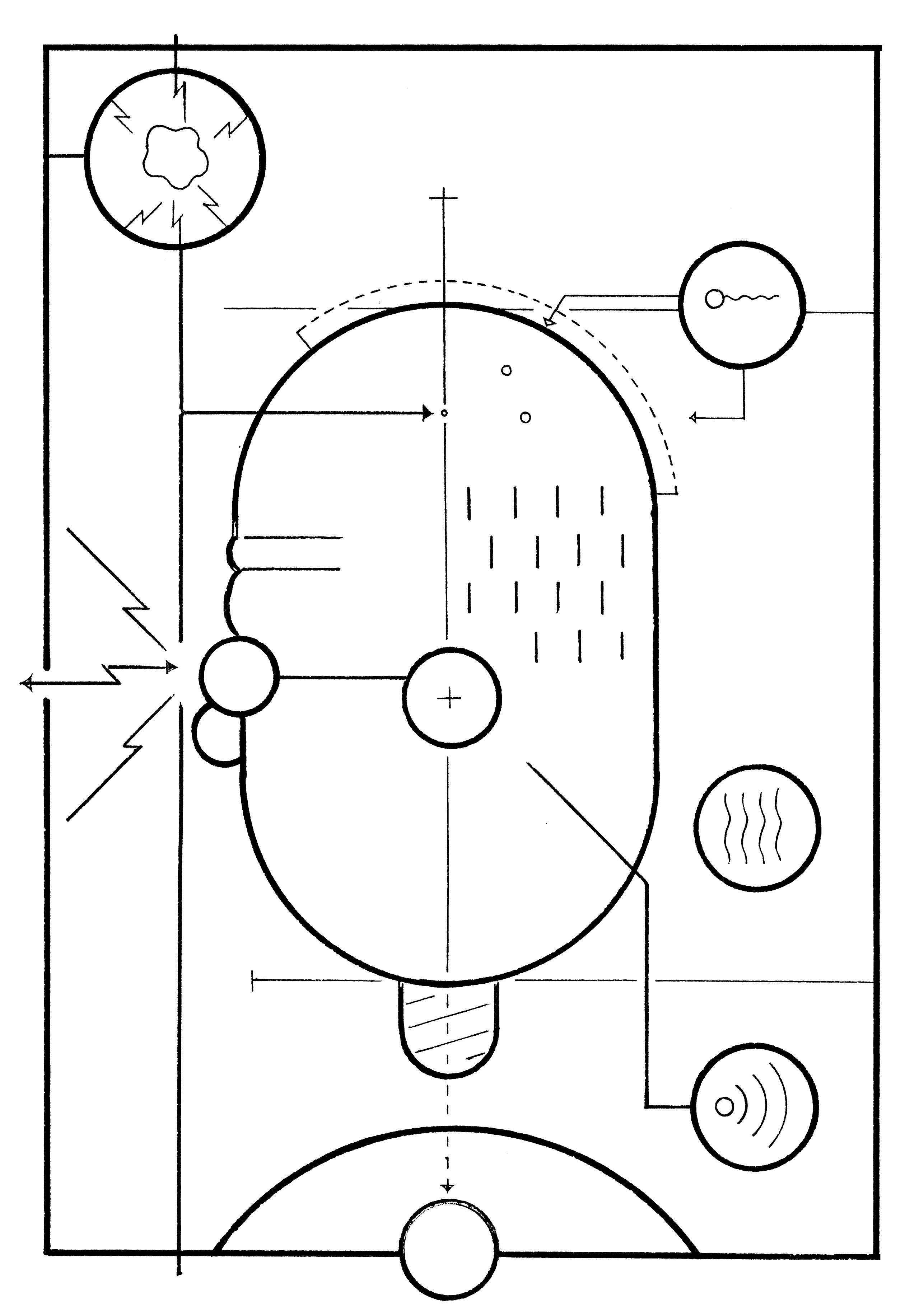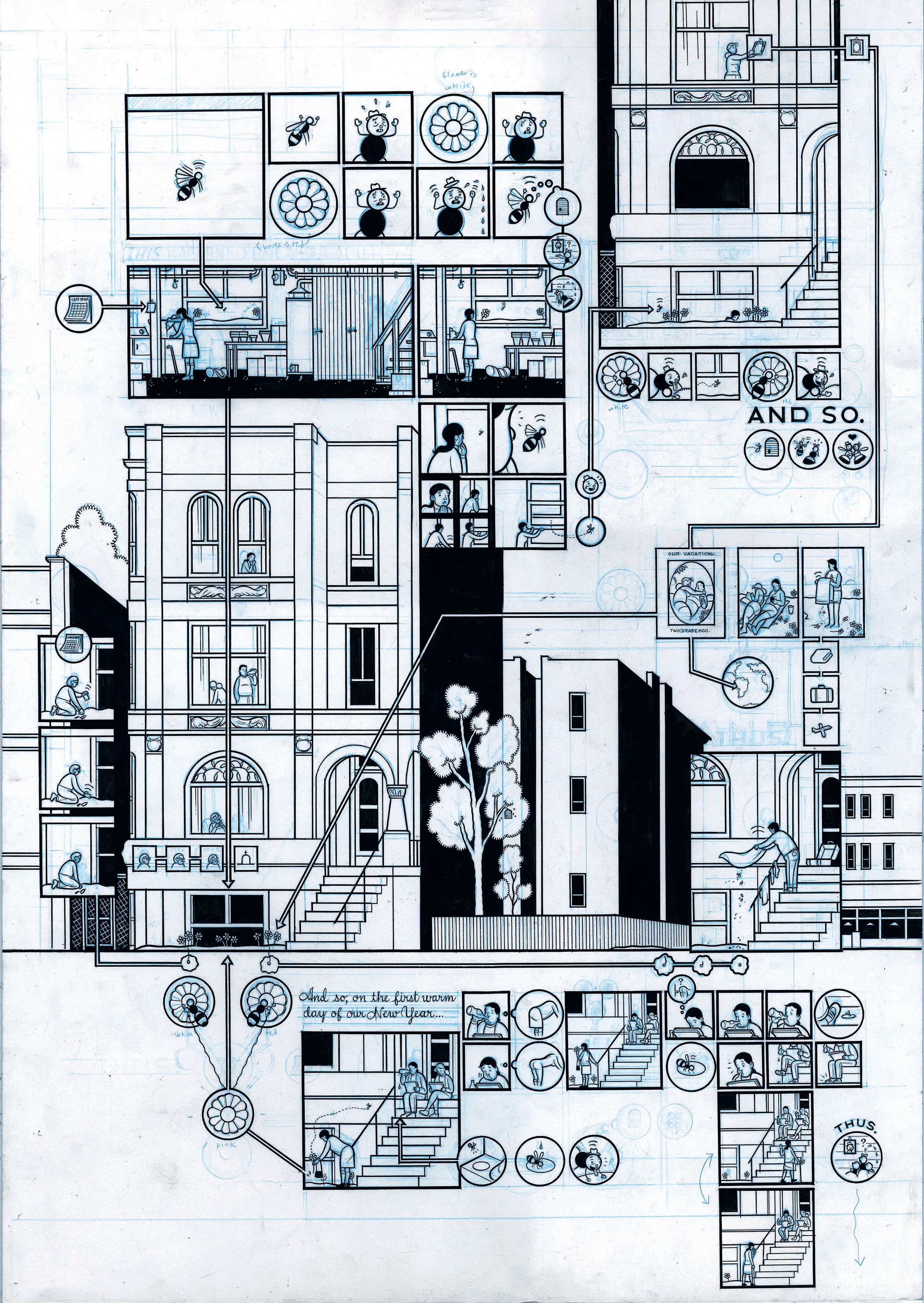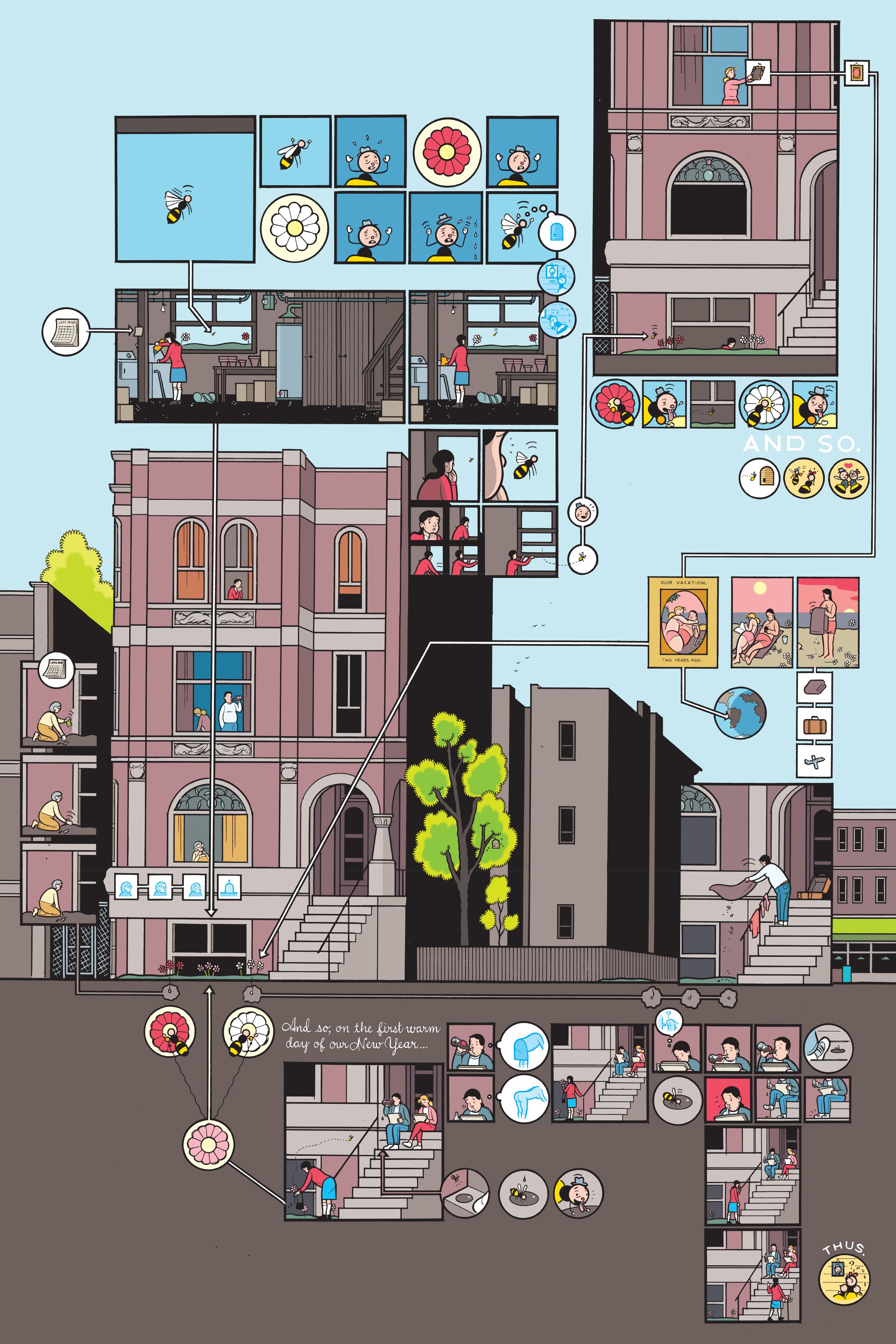Drawing Inspiration:
How Chris Ware Sees Chicago


Drawing by Chris Ware
Drawing by Chris Ware
by Brontë Mansfield (MA 2017)
Over the last 30 years, Chicago’s Loop has experienced a renaissance, anchored by glittering theater marquees and bustling restaurants and shops. But that wasn’t always the case. When artist and writer Chris Ware (SAIC 1991–93, HON 2019) first moved to Chicago in the ’90s, he would bike through the empty Loop at night. “It felt post-apocalyptic, abandoned, filthy, segregated, and miserable yet concomitantly weirdly lawless and unaccountably occasionally inspiring,” Ware said. “I recall the predominant colors being brown and gray. Lots of trash.”
The reality of the city didn’t put Ware off—it was part of the appeal. “Drawing pictures of the world was the reason I came to Chicago,” he explained. “Because it seemed to me to be the city of real, rough life and, of course, the city of the [iconic art collective] Hairy Who—where, when it all came down to it, no one really cared what you did.”

Photo by Gil Roth
Photo by Gil Roth

A self-portrait by Chris Ware. Image courtesy of Chris Ware
A self-portrait by Chris Ware. Image courtesy of Chris Ware

Photo by Gil Roth

A self-portrait by Chris Ware. Image courtesy of Chris Ware
Ware was born and raised in Nebraska and went to college at the University of Texas at Austin. It was there in the 1980s that Ware began publishing comic strips in the student newspaper and eventually caught the attention of Art Spiegelman, creator of Maus, the first graphic novel to win a Pulitzer Prize. After contributing to Spiegelman’s publication Raw, Ware decided to pursue a graduate degree in art to develop his skills as an artistic storyteller. Ware matriculated at the School of the Art Institute of Chicago (SAIC) for a master of fine arts in printmaking—and quickly learned that at a school renowned for conceptualism, some considered realism passé.
Subsisting on corn tortillas, eggs, refried beans, peanut butter, and Dunkin’ Donuts coffee, Ware would spend long hours in his studio “trying to get ever better at writing, drawing from life.” He was “sketching people, places, and things on the bus and train and feeling especially talentless and self-conscious about it, since drawing recognizable images was still largely frowned upon in the art world.”
Ware found some rare encouragement from Richard Keane, “a talented and loquacious 70-plus [year-old] professor emeritus teaching a single life drawing class.” Keane shared stories about teaching at SAIC in the 1950s, when he was one of only two teachers “still representing the human form, to their occasional ridicule by the rest of the faculty,” Ware recalled.
This reminded Ware of the cycles of art throughout history. “I started to feel as if we were all living through another Middle Ages,” he said. “All of us students, the monks and nuns, doing only what the church had approved or was permitting us to do.”
If life drawing was caught in a riptide, Ware’s comics—and treating those stories as art—were entirely out to sea. While in graduate school, Ware started publishing his comics in the local alt-weekly Newcity. “I would occasionally bring in my printed weekly strips [to school], which were criticized with varying degrees of seriousness. I probably don't need to highlight the fact that cartooning wasn't an accepted part of the curriculum or even really the general culture then,” Ware explained.

Chris Ware, from Jimmy Corrigan: The Smartest Kid on Earth, 1999. Image courtesy of Chris Ware
Chris Ware, from Jimmy Corrigan: The Smartest Kid on Earth, 1999. Image courtesy of Chris Ware
The eternally self-deprecating Ware summarizes his time in graduate school as “a wonderful two years of self-consciousness, self-doubt, self-misery, and crushing loneliness,” he said, “yet also two years that provided lifelong friendships.”
What Ware ultimately learned from his peers was how to sift through their criticism. “Now, when I think back on all this I realize how timid I was being; it's completely ludicrous to care what anyone would think was appropriate or, even worse, permissible in one's artwork,” explained Ware. “My time at SAIC taught me, however indirectly, the only thing I could control about my life was my own artwork, and the only person I should answer to about it was me. Any ‘success’ that came along was secondary. I really think there's no more important lesson than that.”
Ware’s success, however secondary he sees it, has been immense. In the years after graduate school, he published a series called Acme Novelty Library, where he first serialized some of his most famous works, including Quimby the Mouse and Jimmy Corrigan: The Smartest Kid on Earth. His images have graced the cover of 25 New Yorker magazines, he produced animations for a television adaptation of This American Life, was featured in an Art21 episode, and published his novel Rusty Brown. Finally, thanks in part to Ware’s work, the comics tide came in and continues to sweep up the art world: Ware was the first artist to exhibit comics at the Whitney Biennial in 2002, and by 2006, he had a solo exhibition at the Museum of Contemporary Art Chicago (MCA). In June, his work will return to the MCA for the museum’s Chicago Comics exhibition, and he is curating a show of early Chicago comics for the Chicago Cultural Center.

Chris Ware, Drop Off, 2012, New Yorker. Image courtesy of Chris Ware
Chris Ware, Drop Off, 2012, New Yorker. Image courtesy of Chris Ware
“My time at SAIC taught me, however indirectly, the only thing I could control about my life was my own artwork, and the only person I should answer to about it was me. Any ‘success’ that came along was secondary. I really think there's no more important lesson than that.”

Chris Ware teaches Comics, Emotional Directness, and Self-Doubt as SAIC's 2015–16 Bill and Stephanie Sick Distinguished Visiting Professor.
Chris Ware teaches Comics, Emotional Directness, and Self-Doubt as SAIC's 2015–16 Bill and Stephanie Sick Distinguished Visiting Professor.
Now, if you can manage to get a spot in one of SAIC’s comics classes—they are frequently waitlisted—you’ll often see Ware’s name printed on the syllabus. Just over two decades after his comics were seen by the art world as just a weekly paycheck, Ware’s work is now required reading.
Ware continues to make Chicago a permanent fixture in his life and art. The city is a setting and something like a character in many of his comics, especially in his 2012 graphic novel Building Stories.
The titular building is a classic Chicago three-flat and shares the interconnected stories of the people (and one bumblebee) who live in the apartments. None of the works are numbered, so you simply drop into the story and stitch the pieces together over time. On one page of the work, Ware shares the history of the 98-year-old building in numbers: 13,246 light bulbs; 296 birthday parties; 4,167 takeout orders; five wars. It feels like the building is alive and holding on to memories.

Chris Ware, from Building Stories, 2005. Image courtesy of Chris Ware
Chris Ware, from Building Stories, 2005. Image courtesy of Chris Ware

Chris Ware, Spring, 2002, from Building Stories. Original drawing courtesy of Chris Ware
Chris Ware, Spring, 2002, from Building Stories. Original drawing courtesy of Chris Ware

Chris Ware, Spring, 2002, from Building Stories. Original drawing courtesy of Chris Ware
Chris Ware, Spring, 2002, from Building Stories. Original drawing courtesy of Chris Ware

Chris Ware, Spring, 2002, from Building Stories. Image courtesy of Chris Ware
Chris Ware, Spring, 2002, from Building Stories. Image courtesy of Chris Ware

Chris Ware, Spring, 2002, from Building Stories. Image courtesy of Chris Ware
Chris Ware, Spring, 2002, from Building Stories. Image courtesy of Chris Ware

Chris Ware, Spring, 2002, from Building Stories. Original drawing courtesy of Chris Ware

Chris Ware, Spring, 2002, from Building Stories. Image courtesy of Chris Ware
Building Stories is uncannily relevant to the current pandemic era, when we are stuck and nestled inside our homes, shaping and being shaped by our spaces unlike ever before. “Everyone's home is alive with the memories, activities, and the lives lived within. We design and build homes to not only contain and protect ourselves, but also to contain the most private and personal moments of our experience; it's no accident that these memories are then shaped by the spaces themselves.” Ware said.
When asked what his own home would notice about how he spends his quarantined days, Ware responded: “I fear my own home would be quite tired of having me do the same things every day, over and over, going up and down the stairs, getting up and sitting down from my chair, avoiding work and just generally not going away.”
Since the pandemic began, Ware’s home has watched him create several stirring magazine covers—of New York City in lockdown at the epicenter of the first wave, of a healthcare worker video chatting with family. The house has overheard the conversations Ware sometimes has with his teenage daughter about what details to include that feel real.
We invited Ware to make a cover of Chicago at this odd moment in our shared story. The city today is a lot like the Loop at night when Ware first moved to Chicago: empty and observable. Maybe for the first time, on a long pandemic walk, you’ve really started to see the architectural details and colors of your neighborhood you once glossed over on your rushed morning commute. You stop and stare at a storefront just to look at it. Alleys are for exploring. You find masks littering the sidewalk. Ware observes them too: “My daughter did advise me to make sure that it had enough trash in it to feel accurate.” Across the street, you see rows of apartment windows lined up and peek for a moment into someone else’s story—like panels of a comic. ■

